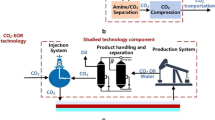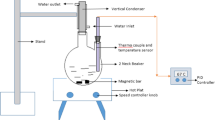Abstract
A comprehensive study was conducted on the characteristics of oxygen-controlled carbonization process of sewage sludge (SS) using thermogravimetric analysis and lab-scale carbonization experiment. Reaction temperature of SS carbonization was varied between 250 and 650 °C in carrier gas with different O2 contents. The thermal process of SS in low oxygen could be divided into three stages: dehydration (below 160 °C), devolatilization (160–380 °C), stubborn volatile decomposition and fixed carbon combustion (380–600 °C). Based on Kissinger–Akahira–Sunose (KAS) and Flynn–Wall–Ozawa (FWO) methods, the reaction activation energy (E) of SS carbonization process in 10% O2 was the lowest, with values of 98.50 kJ mol−1 (KAS) and 103.49 kJ mol−1 (FWO). The properties of the obtained char, tar, and gas products were analyzed by FTIR and GC–MS. With the increase of carbonization temperature, char yield decreased and gas yield increased. The highest yield of tar was 27.76% (N2) and 27.04% (10% O2) at 450 °C. Low-oxygen atmosphere at the same temperature did not change the yield of char but increased the fixed carbon content and its aromaticity. Oxygen would participate in secondary cracking in tar and promote gas generation above 350 °C. It was found that the presence of oxygen not only increased the concentration of H2, CO, and CH4 in gas product, but also improved the quality of tar in terms of high aromatic content and low nitrogen-containing compounds.





Similar content being viewed by others
Availability of data and materials
The datasets generated and analyzed during the current study are available from the corresponding author on reasonable request.
References
Alvarez J, Amutio M, Lopez G, Barbarias I, Bilbao J, Olazar M (2015) Sewage sludge valorization by flash pyrolysis in a conical spouted bed reactor. Chem Eng J 273:173–183. https://doi.org/10.1016/j.cej.2015.03.047
Ates F, Miskolczi N, Saricaoglu B (2015) Pressurized pyrolysis of dried distillers grains with solubles and canola seed press cake in a fixed-bed reactor. Bioresour Technol 177:149–158. https://doi.org/10.1016/j.biortech.2014.10.163
Chanaka WD, Veksha A, Giannis A, Lisak G, Lim T-T (2019) Effects of sewage sludge organic and inorganic constituents on the properties of pyrolysis products. Energy Convers Manage 196:1410–1419. https://doi.org/10.1016/j.enconman.2019.06.025
Chen J, Xie C, Liu J, He Y, Xie W, Zhang X, Chang K, Kuo J, Sun J, Zheng L, Sun S, Buyukada M, Evrendilek F (2018) Co-combustion of sewage sludge and coffee grounds under increased O2/CO2 atmospheres: thermodynamic characteristics, kinetics and artificial neural network modeling. Bioresour Technol 250:230–238. https://doi.org/10.1016/j.biortech.2017.11.031
Chen L, Qi X, Yang J, Xin H (2021) Thermogravimetric and infrared spectral analysis of candle coal pyrolysis under low-oxygen concentration. Thermochimica Acta 696. https://doi.org/10.1016/j.tca.2020.178840
Chen Y, Duan J, Luo Y-h (2008) Investigation of agricultural residues pyrolysis behavior under inert and oxidative conditions. J Anal Appl Pyrol 83:165–174. https://doi.org/10.1016/j.jaap.2008.07.008
Chen Z, Gao S, Xu G (2017) Simultaneous production of CH4-rich syngas and high-quality tar from lignite by the coupling of noncatalytic/catalytic pyrolysis and gasification in a pressurized integrated fluidized bed. Appl Energy 208:1527–1537. https://doi.org/10.1016/j.apenergy.2017.08.227
Cheng F, Luo H, Hu L, Yu B, Luo Z, Fidalgo de Cortalezzi M (2016) Sludge carbonization and activation: from hazardous waste to functional materials for water treatment. J Environ Chem Eng 4:4574–4586. https://doi.org/10.1016/j.jece.2016.11.013
Cheng X, Zhang M, Wang Z, Xu G, Ma C (2018) IR and kinetic study of sewage sludge combustion at different oxygen concentrations. Waste Manag 74:279–287. https://doi.org/10.1016/j.wasman.2018.01.005
Daouk E, Van de Steene L, Paviet F, Salvador S (2015) Thick wood particle pyrolysis in an oxidative atmosphere. Chem Eng Sci 126:608–615. https://doi.org/10.1016/j.ces.2015.01.017
Deng WY, Yan JH, Li XD, Wang F, Zhu XW, Lu SY, Cen KF (2009) Emission characteristics of volatile compounds during sludges drying process. J Hazard Mater 162:186–192. https://doi.org/10.1016/j.jhazmat.2008.05.022
Fonts I, Gea G, Azuara M, Ábrego J, Arauzo J (2012) Sewage sludge pyrolysis for liquid production: a review. Renew Sustain Energy Rev 16:2781–2805. https://doi.org/10.1016/j.rser.2012.02.070
Gai C, Dong Y, Zhang T (2013) The kinetic analysis of the pyrolysis of agricultural residue under non-isothermal conditions. Bioresour Technol 127:298–305. https://doi.org/10.1016/j.biortech.2012.09.089
Huang Q, Wang J, Qiu K, Pan Z, Wang S, Chi Y, Yan J (2015) Catalytic pyrolysis of petroleum sludge for production of hydrogen-enriched syngas. Int J Hydrogen Energy 40:16077–16085. https://doi.org/10.1016/j.ijhydene.2015.09.139
Kim KH, Bai X, Rover M, Brown RC (2014) The effect of low-concentration oxygen in sweep gas during pyrolysis of red oak using a fluidized bed reactor. Fuel 124:49–56. https://doi.org/10.1016/j.fuel.2014.01.086
Li JS, Xue Q, Fang L, Poon CS (2017) Characteristics and metal leachability of incinerated sewage sludge ash and air pollution control residues from Hong Kong evaluated by different methods. Waste Manag 64:161–170. https://doi.org/10.1016/j.wasman.2017.03.033
Li M, Tang Y, Ren N, Zhang Z, Cao Y (2018) Effect of mineral constituents on temperature-dependent structural characterization of carbon fractions in sewage sludge-derived biochar. J Clean Prod 172:3342–3350. https://doi.org/10.1016/j.jclepro.2017.11.090
Liu XQ, Ding HS, Wang YY, Liu WJ, Jiang H (2016) Pyrolytic temperature dependent and ash catalyzed formation of sludge char with ultra-high adsorption to 1-naphthol. Environ Sci Technol 50:2602–2609. https://doi.org/10.1021/acs.est.5b04536
Liu Z, Zhang F, Yan S, Tian L, Wang H, Liu H, Wang H, Hu J (2018) Effects of temperature and low-concentration oxygen on pine wood sawdust briquettes pyrolysis: gas yields and biochar briquettes physical properties. Fuel Process Technol 177:228–236. https://doi.org/10.1016/j.fuproc.2018.05.001
Ma J, Chen M, Yang T, Liu Z, Jiao W, Li D, Gai C (2019) Gasification performance of the hydrochar derived from co-hydrothermal carbonization of sewage sludge and sawdust. Energy 173:732–739. https://doi.org/10.1016/j.energy.2019.02.103
Park SW, Jang CH (2011) Characteristics of carbonized sludge for co-combustion in pulverized coal power plants. Waste Manag 31:523–529. https://doi.org/10.1016/j.wasman.2010.10.009
Peng C, Zhai Y, Zhu Y, Xu B, Wang T, Li C, Zeng G (2016) Production of char from sewage sludge employing hydrothermal carbonization: char properties, combustion behavior and thermal characteristics. Fuel 176:110–118. https://doi.org/10.1016/j.fuel.2016.02.068
Pradel M, Lippi M, Daumer ML, Aissani L (2020) Environmental performances of production and land application of sludge-based phosphate fertilizers-a life cycle assessment case study. Environ Sci Pollut Res Int 27:2054–2070. https://doi.org/10.1007/s11356-019-06910-4
Qi J, Fan C, Li S (2021) Characteristics of lignite char derived from oxy-pyrolysis. Fuel 291. https://doi.org/10.1016/j.fuel.2021.120261
Sever-Akdağ A, Atak O, Atimtay AT, Sanin FD (2018) Co-combustion of sewage sludge from different treatment processes and a lignite coal in a laboratory scale combustor. Energy 158:417–426. https://doi.org/10.1016/j.energy.2018.06.040
Shao Q, Ju Y, Guo W, Xia X, Bian R, Li L, Li W, Liu X, Zheng J, Pan G (2019) Pyrolyzed municipal sewage sludge ensured safe grain production while reduced C emissions in a paddy soil under rice and wheat rotation. Environ Sci Pollut Res Int 26:9244–9256. https://doi.org/10.1007/s11356-019-04417-6
Shen DK, Gu S, Jin B, Fang MX (2011) Thermal degradation mechanisms of wood under inert and oxidative environments using DAEM methods. Bioresour Technol 102:2047–2052. https://doi.org/10.1016/j.biortech.2010.09.081
Syed-Hassan SSA, Wang Y, Hu S, Su S, Xiang J (2017) Thermochemical processing of sewage sludge to energy and fuel: fundamentals, challenges and considerations. Renew Sustain Energy Rev 80:888–913. https://doi.org/10.1016/j.rser.2017.05.262
Trabelsi ABH, Zaafouri K, Friaa A, Abidi S, Naoui S, Jamaaoui F (2021) Municipal sewage sludge energetic conversion as a tool for environmental sustainability: production of innovative biofuels and biochar. Environ Sci Pollut Res Int 28:9777–9791. https://doi.org/10.1007/s11356-020-11400-z
Wang L, Chang Y, Li A (2019) Hydrothermal carbonization for energy-efficient processing of sewage sludge: a review. Renew Sustain Energy Rev 108:423–440. https://doi.org/10.1016/j.rser.2019.04.011
Wang M, Zhao R, Qing S, Liu Y, Zhang A (2017) Study on combustion characteristics of young lignite in mixed O2/CO2 atmosphere. Appl Therm Eng 110:1240–1246. https://doi.org/10.1016/j.applthermaleng.2016.09.026
Werle S, Sobek S (2019) Gasification of sewage sludge within a circular economy perspective: a Polish case study. Environ Sci Pollut Res Int 26:35422–35432. https://doi.org/10.1007/s11356-019-05897-2
Yang G, Zhang G, Wang H (2015a) Current state of sludge production, management, treatment and disposal in China. Water Res 78:60–73. https://doi.org/10.1016/j.watres.2015.04.002
Yang J, Liu J, Liu W, Wang J, Tang T (2015b) Recycling of carbon fibre reinforced epoxy resin composites under various oxygen concentrations in nitrogen–oxygen atmosphere. J Anal Appl Pyrol 112:253–261. https://doi.org/10.1016/j.jaap.2015.01.017
Zhang F, Wu K, Zhou H, Hu Y, Sergei P, Wu H, Wei C (2018a) Ozonation of aqueous phenol catalyzed by biochar produced from sludge obtained in the treatment of coking wastewater. J Environ Manage 224:376–386. https://doi.org/10.1016/j.jenvman.2018.07.038
Zhang J, Lu F, Zhang H, Shao L, Chen D, He P (2015) Multiscale visualization of the structural and characteristic changes of sewage sludge biochar oriented towards potential agronomic and environmental implication. Sci Rep 5:9406. https://doi.org/10.1038/srep09406
Zhang J, Tian Y, Yin L, Zhang J, Drewes JE (2018b) Insight into the effects of biochar as adsorbent and microwave receptor from one-step microwave pyrolysis of sewage sludge. Environ Sci Pollut Res Int 25:18424–18433. https://doi.org/10.1007/s11356-018-2028-9
Zhu K, Qin X, Wang Y, Lin C, Wang Q, Wu K (2021) Effect of the oxygen concentration on the combustion of asphalt binder. J Anal Appl Pyrolysis 160. https://doi.org/10.1016/j.jaap.2021.105370
Acknowledgements
The authors want to appreciate the Analysis and Testing Center of Zhejiang University of Technology for providing detection assistance for this study.
Funding
This work was supported by the projects of the Key Research and Development Program of Zhejiang Province (No. 2022C03092), the National Natural Science Foundation (Grant No. 52170141), and the Zhejiang Provincial Natural Science Foundation of China (Grant No. LQ21E060007).
Author information
Authors and Affiliations
Contributions
FY was in charge of the sampling of the sewage sludge, part of carbonization process analysis and other experiments, and paper writing. YH was the project leader and finished the design of the experiment, data analysis, conclusion, and paper writing. LL and QG were in charge of data analysis and language improvement. YZ and LJ did the measurement of thermogravimetric analysis in sewage sludge and data analysis. YW and XC were in charge of the oxygen-controlled carbonization process of sewage sludge. All authors read and approved the final manuscript.
Corresponding author
Ethics declarations
Ethics approval and consent to participate
No applicable.
Consent for publication
No applicable.
Competing interests
The authors declare no competing interests.
Additional information
Responsible Editor: Ta Yeong Wu
Publisher's note
Springer Nature remains neutral with regard to jurisdictional claims in published maps and institutional affiliations.
Supplementary Information
Below is the link to the electronic supplementary material.
Rights and permissions
About this article
Cite this article
Yu, F., Hu, Y., Li, L. et al. Investigation on oxygen-controlled sewage sludge carbonization with low temperature: from thermal behavior to three-phase product properties. Environ Sci Pollut Res 29, 31441–31452 (2022). https://doi.org/10.1007/s11356-022-18510-w
Received:
Accepted:
Published:
Issue Date:
DOI: https://doi.org/10.1007/s11356-022-18510-w




